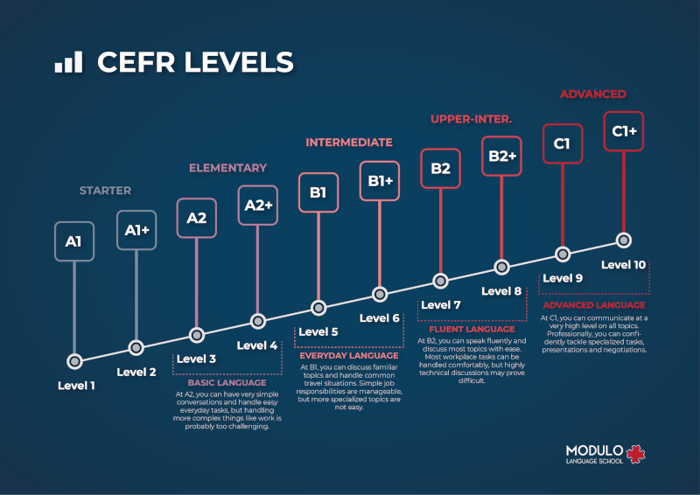CEFR
Les niveaux du CEFR utilisés à l’école de langues Modulo
Modulo utilise le Cadre Européen Commun de Référence pour faire progresser nos étudiants

The Common European Framework of Reference for Languages: Learning, Teaching, Assessment, abbreviated as CEFR, is a guideline used to describe achievements of learners of foreign languages across Europe and, increasingly, in other countries. Its main aim is to provide a method of learning, teaching and assessing which applies to all languages in Europe, such as English and French. The six reference levels (see above) are becoming widely accepted as the European and international standard for grading an individual's language proficiency.
Try our free online test!
The Modulo Experience
How we use the CEFR to help you succeed
We guide you step by step:
- Contact us
Getting in touch with one of our language advisors is the first step to successful language learning. Whether you call or message us, we will take good care of you and ensure you get the personalized learning experience you deserve. - Wants analysis
What you want is at the heart of everything we do at Modulo. We will ask you a few questions about your goals and dreams, about how you plan on using the language, and about how you prefer to improve your skills. - Assessment/Demo
Let's find out what you need. Book an appointment with one of our teachers to analyze your strengths and weaknesses in a relaxed environment. If you're a beginner, we will teach your first lesson to show you what we can do. - Personalized solution
Now that we know what you want and what you need, we can work together to find the best possible solution so you can reach your objectives. We will recommend a level to study at and a specific course to follow, as well as a detailed timeline. - Studying the language
Not only will you study with our excellent Modulo teachers, we will ensure your progress and satisfaction with regular Checkpoint units and ask you for feedback on how the course is going so we can continue improving your learning experience.
Meet our language advisors and teachers in the coming days and they will help you find the best way to achieve your language goals!
Level descriptions
An overview of the CEFR levels at Modulo
Modulo offers a range of courses that can be further customized to your needs.
| Level | CEFR | Description |
|---|---|---|
| 1 | A1 |
|
| 2 | A1+ | |
| 3 | A2 |
|
| 4 | A2+ | |
| 5 | B1 |
|
| 6 | B1+ | |
| 7 | B2 |
|
| 8 | B2+ | |
| 9 | C1 |
|
| 10 | C1+ | |
| 11 | C2 |
|
| 12 | C2+ |